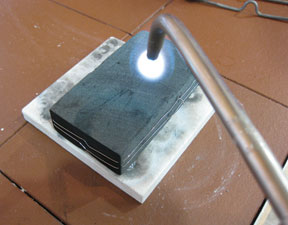Magnesia Blocks Myth Debunked
Myth: Magnesia blocks are superior soldering surfaces to charcoal blocks: A topic that seems to raise a fair amount of spirited discussion and strong opinions is what is the best soldering surface: firebrick, charcoal, magnesia, solderite - the list goes on. Charcoal is a very traditional choice, but it is seen as having limitations in terms of both longevity and safety. I was curious to see if any of the practices out there served to really mitigate these issues, and how charcoal compares to magnesia, another popular choice.
3 Minute Read
During a recent conversation with a colleague, I came under some good-natured fire for one of my studio habits: I singe my buffs. Why, you ask? I can offer any number of reasons, but the most honest answer is simply that it's how I learned to prepare a muslin buff, so it's the method I continue to use.
But the teasing gave me pause; how do I really know that this is a good approach? Am I trusting habit, tradition, or superstition? And that led me to a broader question: How many of us rely on habit, tradition, or superstition at the bench?
I suspected that the answer to this question is many, so I conducted an informal e-mail survey of the bench jewelers, designers, and educators that I know. The results indicate that there may be as many firmly held beliefs and practices as there are folks who sit at the bench. While I can't prove or disprove the effectiveness of always patting your dog before leaving for the shop, or soldering with your tongue at the corner of your mouth, I can take a look at bench preparation and practices with an analytical eye.
The first of these myth challenges follows.
Myth:
Magnesia Blocks are superior soldering surfaces to Charcoal Blocks
A topic that seems to raise a fair amount of spirited discussion and strong opinions is what is the best soldering surface: firebrick, charcoal, magnesia, solderite-the list goes on. Charcoal is a very traditional choice, but it is seen as having limitations in terms of both longevity and safety. I was curious to see if any of the practices out there served to really mitigate these issues, and how charcoal compares to magnesia, another popular choice.
One common practice to extend the lifespan of a non-compressed charcoal block is to wrap it with a length of binding wire to keep it from splitting apart when heated. Also, Jurgen Maerz of Platinum Guild International told me that he employs an annealing step to help stabilize the block after binding it.
I started my exploration with three unused blocks: two non-compressed charcoal blocks and one magnesia block. I left one charcoal block and the magnesia block completely unaltered, and I wrapped one charcoal block in binding wire and gently heated it with a large reducing flame for about a minute. I then used all three to anneal a small piece of gold and observed the results. It was not a surprise when the magnesia block remained unchanged except for the typical discoloration on the surface, and the unaltered charcoal block split quite dramatically from one edge to the other. What did surprise me was that the charcoal block that was bound and annealed stayed completely stable, and I didn't hear the crackling that so often accompanies the first few uses of a charcoal block.
I then used both charcoal blocks for the same soldering operation to see if there was any discernable difference, and found that they performed similarly. The only slight difference was the amount of ash and smoldering: the annealed block showed a bit less surface degradation. This led me to conclude that this simple annealing step may, in fact, improve the life span of a charcoal block. I am not comfortable concluding that it makes the use of charcoal any safer by minimizing smoldering, as subsequent soldering operations will break down the surface, and sparking and smoldering will still be an issue. Still, it is a point scored for tradition!
An examination of my soldering bench, however, does take a bit of the glory out of charcoal's victory here. Like many other goldsmiths, I am a bit frugal, and therefore tend to keep my soldering media until it is utterly unusable for any conceivable purpose. And the reality is that my collection of charcoal block fragments eclipses the magnesia block leftovers even though I use magnesia blocks more regularly than charcoal. Magnesia does not tend to fracture or fall apart given its fibrous composition, and responds nicely to repeated resurfacing. Charcoal simply can't compete. But charcoal provides a reducing atmosphere and reflects heat in a way that is extremely beneficial when working in sterling silver and for operations such as fusing and fabricating large cabochon bezels.
Magnesia blocks do not offer these benefits. For my purposes, both will continue to see regular use in my studio, but I have high hopes that this newly acquired trick will allow me to use charcoal more economically in the future.
The award-winning Journal is published monthly by MJSA, the trade association for professional jewelry makers, designers, and related suppliers. It offers design ideas, fabrication and production techniques, bench tips, business and marketing insights, and trend and technology updates—the information crucial for business success. “More than other publications, MJSA Journal is oriented toward people like me: those trying to earn a living by designing and making jewelry,” says Jim Binnion of James Binnion Metal Arts.
Click here to read our latest articles
Click here to get a FREE four-month trial subscription.
You assume all responsibility and risk for the use of the safety resources available on or through this web page. The International Gem Society LLC does not assume any liability for the materials, information and opinions provided on, or available through, this web page. No advice or information provided by this website shall create any warranty. Reliance on such advice, information or the content of this web page is solely at your own risk, including without limitation any safety guidelines, resources or precautions, or any other information related to safety that may be available on or through this web page. The International Gem Society LLC disclaims any liability for injury, death or damages resulting from the use thereof.
The All-In-One Jewelry Making Solution At Your Fingertips
When you join the Ganoksin community, you get the tools you need to take your work to the next level.
Trusted Jewelry Making Information & Techniques
Sign up to receive the latest articles, techniques, and inspirations with our free newsletter.



